|
My 1991 745 Turbo has sat for about 15 months, and had about 5/8 to 3/4 of a tank of gas when I parked it in the garage, in late June last year. Still has the same amount of gas in it now.
Finally went to try to start it up, after the longest head replacement job in history. It turned over but would not start. After pulling one of the spark plugs, and then the fuel return hose (from the pressure regulator) and finding both bone dry, I conclude that she is not getting any gas to the engine.
Both pumps are running just fine.
I guess that the problem is old fuel that has varnished up everything. What do I have to do to clean it out? Change the main filter, under the frame for sure. Do I have to pull out the in-tank pump too and check the filter sock, or if I drain out all or most of the old gas and refill with about a half a tank (about 8 gal.) of fresh fuel, will that dissolve any varnish in the in-tank filter sock? Would adding some Redline SI or STP Fuel System Cleaner, or the BMW stuff, or whatever help to clean out the sock? I really, really don't want to have to pull the in tank pump/sender unit out. Is there anything else that I need to clean out?
--
1955 Human, Scott; 1991 745 Turbo, Thunderbolt; 1990 745GL, Posideon
|

